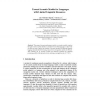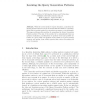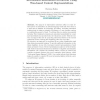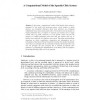CICLING
2005
Springer
15 years 2 months ago
2005
Springer
Recent years have seen increasing interest in automatic metrics for the evaluation of generation systems. When a system can generate syntactic variation, automatic evaluation becom...
98
Voted
CICLING
2005
Springer
15 years 2 months ago
2005
Springer
We use prior and boundary estimates as the approximation of outside probability and establish our beam thresholding strategies based on these estimates. Lexical items, e.g. head wo...
CICLING
2005
Springer
15 years 2 months ago
2005
Springer
This paper discuses preliminary results on acoustic models creation through acoustic models already in existence for another language. In this work we show as case of study, the cr...
CICLING
2005
Springer
15 years 6 months ago
2005
Springer
Abstract. With the current method of query formation, a Question Answering system retrieves a set of documents that are similar to a question, while what is mostly required is a se...
107
Voted
CICLING
2005
Springer
15 years 6 months ago
2005
Springer
Abstract. The purpose of information extraction (IE) is to find desired pieces of information in natural language texts and store them in a form that is suitable for automatic pro...
CICLING
2005
Springer
15 years 6 months ago
2005
Springer
Abstract. This paper describes our work in integrating three different lexical resources: FrameNet, VerbNet, and WordNet, into a unified, richer knowledge-base, to the end of ena...
CICLING
2005
Springer
15 years 6 months ago
2005
Springer
This paper presents the design and development of a system for the detection and correction of syntactic errors in free texts. The system is composed of three main modules: a) a ro...
CICLING
2005
Springer
15 years 6 months ago
2005
Springer
This paper presents a prosodically conditioned diphone database to be used in a Korean text-to-speech (TTS) synthesis system. The diphones are prosodically conditioned in the sense...
128
click to vote
CICLING
2005
Springer
15 years 6 months ago
2005
Springer
The problem of the resolution of the lexical ambiguity, which is commonly referred as Word Sense Disambiguation (WSD), seems to be stuck because of the knowledge acquisition bottle...
CICLING
2005
Springer
15 years 6 months ago
2005
Springer
In this paper a computational model of the Spanish clitic system is presented. In this model clitic pronouns receive a dual analysis in which enclitics are considered inflexions wh...







